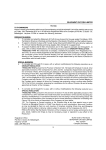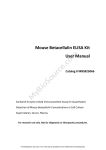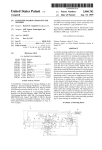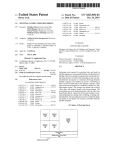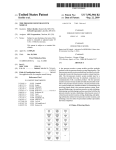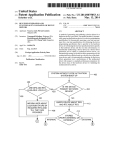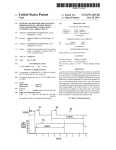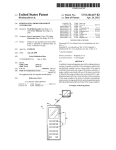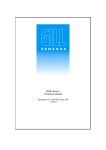Download | 5 Lam |
Transcript
US008459805B2 (12) United States Patent (10) Patent N0.: (45) Date of Patent: Nakagawa et a]. (54) DISPLAY APPARATUS (56) (75) Inventors: Tomohiro NakagaWa, Tokyo (JP); Tsutomu Katou, Tokyo (JP) Notice: Sub'ect to any disclaimer, the term of this J References Cited 7,072,003 B2 * 7/2006 7,106,383 B2 9/2006 Kahn 11/2006 Koide ........................... .. 353/20 2/2007 Stone et al. 348/558 7,598,948 B1 * 7,802,288 B2 * 10/2009 9/2010 PCT Filed: Jul. 17, 2008 (86) PCT N0.: PCT/JP2008/063326 § 371 (00)’ (2), (4) Date: FOREIGN PATENT DOCUMENTS 2002-196736 2003-348496 JP JP (22) Priem ...... .. 345/204 Sie et al. ..................... .. 725/116 (Continued) U.S.C. 154(b) by 505 days. 12/452,5s9 Stahl et al. ...................... .. 349/5 7,131,730 B2 * 7,176,980 B2 * patent is extended or adjusted under 35 (21) Appl. N0.: Jun. 11, 2013 U.S. PATENT DOCUMENTS (73) Assignee: NEC Display Solutions, Ltd., Tokyo (JP) * US 8,459,805 B2 7/2002 12/2003 (Continued) OTHER PUBLICATIONS Japanese Of?ce Action dated Aug. 31, 2011, with partial English Jan. 11, 2010 translation. (Continued) (87) PCTPub.No.: WO2009/014192 PCT Pub. Date: Jan. 29, 2009 Primary Examiner * GeorgiaY Epps (65) Prior Publication Data US 2010/0128185 A1 (30) Assistant Examiner * Sultan ChoWdhury (74) Attorney, Agent, or Firm *McGinn IP LaW Group, May 27,2010 PLLC Foreign Application Priority Data Jul. 25, 2007 (JP) ............................... .. 2007-193279 (51) Int. Cl. (52) G03B 21/00 US. Cl. (2006.01) USPC ............... .. 353/122; 353/30; 353/71; 353/94; 345/204; 345/650; 348/556 (58) Field of Classi?cation Search USPC .... .. 353/69, 30, 70, 94, 71, 31, 122; 349/5i9, 349/345, 348, 715; 345/204, 419, 619, 649, 345/650; 348/556, 558, 555, 231.99, 744, (57) ABSTRACT A display apparatus is capable of displaying a distortion-free projected image based on an image signal from a computer. The display apparatus receives an image signal from the computer and projects an image depending on the image signal onto a projection surface. The display apparatus includes a setting section Which sets identi?cation informa tion representative of an aspect ratio of a display of the com puter. The identi?cation information set in the setting section can be changed by the user. 348/745 See application ?le for complete search history. 14 Claims, 3 Drawing Sheets 1 | 5 SCL Lam 7 | 6 N l N 4 SDA N SDA swrrcaaa 5 N comgLLzx SCL Hrnomc'rmu szc'uon SCL N N 3 SDA B N 2 /\/ l mm sm'rmc sscnou I sum STORAGE US 8,459,805 B2 Page 2 US. PATENT DOCUMENTS FOREIGN PATENT DOCUMENTS JP 7,884,836 B2* 7,904,632 B2* 2/2011 3/2011 Hussain ...................... .. 345/649 Sakasegawa ................ .. 710/316 7,999,816 B2 8/2011 Onumaetal. 5883833332; iii 5/5882 Isiah“ 1'11 """""""""" " ZZZ/223 onee 2006/0017751 A1 . ................. .. JP JP 8/2006 Panabaker .................. .. 348/556 2006/0238648 Al* 2007/0035707 Al* 2007/0050294 A1 * 10/2006 Wogsberg ................... .. 348/441 2/2007 Margulis . 353/122 3/2007 Trottier et a1. ................ .. 705/50 4/2004 4/2004 V2005 g 3882:1155; A $588; JP 2007-11035 H2007 1/2006 Shintani 6161. 2006/0176397 Al* 2004102067 A 2004-102067(A) 2005-6311(15) OTHER PUBLICATIONS Japanese Of?ceAction datedJan.3l,20l2 (WithanEnglishtransla tion), * cited by examiner US. Patent Jun. 11,2013 Sheet 1 of3 US 8,459,805 B2 or .6:~ “'2. US. Patent Jun. 11,2013 Sheet 3 of3 US 8,459,805 B2 Fig. 3 1 O O DETECT SIGNAL REQUESTING TRANSMISSION /\/ OF IMAGE SIGNAL 1 O 1 PROJECT SELECTION SCREEN ONTO PROJECTION SURFACE l INSTRUCT SWITCHER TO CHANGE CONNECTION i 1O2 /\/ 1O3 READ EDID l 1O4 SET EDID l INSTRUCT SWITCHER TO CHANGE CONNECTION 1O5 /\/ US 8,459,805 B2 1 2 DISPLAY APPARATUS The above and other purposes, features, and advantages of the present invention Will become apparent from the folloW ing description With reference to the accompanying draWings BACKGROUND OF THE INVENTION Which illustrate examples of the present invention. 1. Field of the Invention The present invention relates to a display apparatus for BRIEF DESCRIPTION OF THE DRAWINGS projecting an image. 2. Description of the Related Art FIG. 1 is a vieW shoWing an arrangement of an image projection system incorporating a projector according to an exemplary embodiment of the present invention; FIG. 2 is a block diagram of the projector shoWn in FIG. 1; Projectors receive an image signal from a personal com puter and project an image depending on the image signal onto a screen. The image projected from the projector onto the screen generally has an aspect ratio of 4:3. The aspect ratio refers to the ratio of the horiZontal siZe to vertical siZe of the and FIG. 3 is a ?owchart of an operation sequence of the pro jector shoWn in FIG. 2. image. Some personal computers (hereinafter referred to as an “ordinary PC”) have a display aspect ratio of 4:3 and others (hereinafter referred to as “Wide PC”) have a display aspect ratio of 16:9, 16:10, or 15:9. These computers employ image signals corresponding to the aspect ratios of their displays. DETAILED DESCRIPTION OF THE EXEMPLARY EMBODIMENT 20 When a projector having an aspect ratio of 4:3 receives an image signal from an ordinary PC having a display aspect ratio of 4:3, the projector projects a distortion-free image that is identical to the image displayed on the display screen of the ordinary PC. 25 HoWever, When a projector having an aspect ratio of 4:3 receives an image signal from a Wide PC having a display aspect ratio of 16:9, the projector projects an image at the aspect ratio of 4:3 though the image shouldbe displayed at the aspect ratio of 16:9. Therefore, the image projected from the projector onto the screen is distorted, i.e., it is compressed An exemplary embodiment of the present invention Will be described in detail beloW With reference to the draWings. FIG. 1 shoWs an arrangement of an image projection sys tem incorporating a projector according to an exemplary embodiment of the present invention. As shoWn in FIG. 1, the image projection system includes projector 1 and Wide PC 10. Projector 1 stores a plurality of EDID (Extended Display Identi?cation Data) representing different aspect ratios, respectively. The user of projector 1 sets EDID representing the aspect ratio of the display of a computer. 30 Wide PC 10 can be connected to projector 1 through con nection cable 9. When Wide PC 10 is connected to projector 1 horizontally and expanded vertically, and is not easily vieW through connection cable 9, Wide PC 10 acquires the EDID able. JP-A No. 2003-348496 (hereinafter referred to as “Patent set in projector 1. Wide PC 10 outputs an image signal having an aspect ratio Document 1”) discloses a projector for making screen-pro 35 jected images easily vieWable. Speci?cally, the projector dis closed in Patent Document 1 identi?es the aspect ratio of an image frame based on the image signal sent from a PC. If the image from the PC is a high-de?nition image, then the pro jector identi?es the aspect ratio of the image as 16:9. If the image from the PC is an ordinary image, then the projector identi?es the aspect ratio of the image as 4:3. The projector projects the image at the identi?ed aspect ratio onto the projection surface. 40 controller 8. 45 dif?cult for the projector to properly identify the aspect ratios of image signals Which are similar to each other, e.g., the aspect ratios of 15:9, 16:9, and 16:10. Ifthe projector fails to identify the aspect ratio of an image, then it cannot project the image at its oWn aspect ratio, but projects an image that is not EDID storage 2 stores a plurality of EDID. The EDID refer to data in a format according to VESA (Video Electronics Standards Association), including information about display types and display performances. For example, EDID storage SUMMARY OF THE INVENTION 55 It is an exemplary purpose of the present invention to 2 stores EDID representing an aspect ratio of 4:3 (hereinafter referred to as 4:3 EDID), EDID representing an aspect ratio of 16: 9 (hereinafter referred to as 16:9 EDID), EDID represent ing an aspect ratio of 16:10 (hereinafter referred to as 16: 10 EDID), and EDID representing an aspect ratio of 15:9 (here inafter referred to as 15:9 EDID). 60 Initially, EDID setting section 3 has the 4:3 EDID, for example, set therein as initial data. Thereafter, the user of projector 1 sets a desired one of the plural EDID stored in surface, comprising: a setting section Which sets identi?cation information rep resentative of an aspect ratio of a display of the computer; Wherein the identi?cation information set in the setting section is changeable by a user. Controller 8 is connected to projecting section 5, key input section 6, and EDID storage 2. EDID setting section 3 is selectively connected to input/ output section 7 and controller 8 by an I2C (Inter-Integrated Circuit) bus. The I2C bus employs tWo lines, i.e., a serial data line (SDA) and a serial clock line (SCL). 50 easily vieWable. provide a display apparatus Which Will solve the above and other problems and Which can project distortion-free images. To achieve the above and other purposes, there is provided in accordance With the present invention a display apparatus for receiving an image signal from a computer and projecting an image depending on the image signal onto a projection Details of the arrangement of projector 1 Will be described beloW With reference to FIG. 2. Projector 1 includes EDID storage 2, EDID setting section 3, sWitcher 4, projecting section 5, key input section 6, input/output section 7, and screen. The projector disclosed in Patent Document 1 thus identi ?es the aspect ratio based on the image signal. HoWever, it is indicated by the acquired EDID to projector 1. When projec tor 1 receives the image signal from Wide PC 10, projector 1 projects an image depending on the image signal onto a EDID storage 2. SWitcher 4 connects EDID setting section 3 to either input/ 65 output section 7 or controller 8 according to an instruction from controller 8. EDID setting section 3 is normally con nected to input/ output section 7 through sWitcher 4. US 8,459,805 B2 4 3 Projecting section 5 projects an image depending on an FIG. 3 is a ?owchart of an operation sequence of projector 1 shoWn in FIG. 2. Controller 8 receives a signal requesting the transmission of an image signal for a selection screen from key input image signal from controller 8 onto the projection surface. The projection surface may include a screen or a Wall. When controller 8 sends an image signal generated by Wide PC 10 to projecting section 5, projection section 5 projects an image section 6 (step 100), and sends an image signal representative having an aspect ratio depending on the image signal onto the of a selection screen to projecting section 5. Projecting sec projection surface. tion 5 projects the selection screen based on the image signal received from controller 8 onto the projection surface (step When Wide PC 10 is connected to input/output section 7 by connection cable 9, Wide PC 10 operates in a “plug-and-play” manner. Plug-and-play is a feature of Wide PC 10 in Which When projector 1 and Wide PC 10 are connected to each other, 101). 10 the OS (Operating System) of Wide PC 10 automatically detects projector 1 and makes optimum settings Without the user’s manual intervention. Plug-and-play is based on requirement speci?cations de?ned by Microsoft (registered trademark) Corporation. Interface standards of plug-and-play aspect ratio indicating signal received from key input section 6, from EDID storage 2 (step 103). Controller 8 then sets the read EDID in EDID setting unit 3 (step 104). Controller 8 instructs sWitcher 4 to change the connection of EDID setting section 3 from controller 8 to input/output section 7 (step include USB (Universal Serial Bus) and IEEE 1394 (Institute of Electrical and Electronic Engineers 1394). Control data are exchanged betWeen Wide PC 10 and projector 1 for plug-and play according to these standards. When input/ output section 7 is connected to Wide PC 10 by 20 projector 1, the EDID representative of the aspect ratio of the 10 is a computer having a function to read the EDID set in display of a computer as Wide PC 10 are set as identi?cation 25 30 35 Before a PC is connected to projector 1, the user checks the aspect ratio of the PC. The user controls projector 1 to display data, and sends the generated image signal to projecting sec 40 tion screen by projecting section 5. For example, the selection screen displays selection items indicative of the aspect ratios of“4:3”, “16:9”, “16:10”, and “15:9” or others as appropriate. after, controller 8 instructs sWitcher 4 to change the connec tion of EDID setting section 3 from controller 8 to input/ output section 7, and controls projecting section 5 to display 50 After the mes sage has been displayed, the user connects the 55 tion 5. Projecting section 5 displays an image based on the image signal sent from controller 8. PC to projector 1. When the PC is connected to projector 1, the PC acquires the EDID set in EDID setting section 3 in a plug-and-play session. 60 Controller 8 and input/output section 7 are connected to each other by an ordinary route (not shoWn) separate from the I2C bus. Controller 8 receives an image signal supplied from Wide PC 10 to input/output section 7 through the ordinary route, and sends the received image signal to projecting sec a message Which shoWs that the EDID of the aspect ratio set by the user are properly set in the EDID setting section 3, on the projection surface. input/output section 7 to controller 8. Controller 8 then reads the EDID Which has the aspect ratio indicated by the aspect EDID storage 2, and sets the read EDID in EDID setting unit 3. When the setting of the EDID is ?nished, controller 8 instructs sWitcher 4 to change the connection of EDID setting section 3 from controller 8 to input/output section 7. In this manner, the EDID setting can be changed easily. a screen for selecting an aspect ratio, and speci?es, on the displayed screen, an item corresponding to the aspect ratio of the PC to be connected to projector 1. When the user has speci?ed the aspect ratio, controller 8 changes the connection of EDID setting section 3 from input/ output section 7 to controller 8, acquires the EDID Which corresponds to the speci?ed aspect ratio from EDID storage 2, and sets the acquired EDID in EDID setting unit 3. There After the selection screen is displayed, When the user ratio indicating signal received from key input section 6, from 16:10, etc. The image displayed by the display apparatus is thus prevented from being distorted. Operation of projector 1 in a speci?c example of usage of projector 1 Will be described beloW. representative of the selection screen based on the acquired presses a decision button (not shoWn) of key input section 6 for indicating the aspect ratio of an image to be projected, key input section 6 outputs a signal indicative of the aspect ratio (aspect ratio indicating signal) to controller 8. When controller 8 receives the aspect ratio indicating sig nal from key input section 6, controller 8 instructs sWitcher 4 to change the connection of EDID setting section 3 from identi?cation information. Since the aspect ratio is not iden ti?ed based on the image signal from the computer, but iden ti?ed based on the identi?cation information set in the display apparatus, the display apparatus can project a distortion-free image based on the image signal Which may be either one of image signals having similar aspect ratios, e.g. 15:9, 16:9, representing a selection screen. tion 5. The selection screen includes contents (items) for the user to select an aspect ratio, and is displayed on the proj ec information, and an image based on an image signal from the computer is projected at the aspect ratio indicated by the user, key input section 6 supplies controller 8 With a selection screen display request signal for sending an image signal In response to the selection screen display request signal, controller 8 acquires data representative of the selection screen from a memory (not shoWn), generates an image signal 105). According to the present exemplary embodiment, as described above, in a display apparatus that is provided as connection cable 9, Wide PC 10 acquires the EDID set in EDID setting section 3 in a plug-and-play session. Wide PC EDID setting section 3 in a plug-and-play session. When input/output section 7 is connected to Wide PC 10, therefore, the EDID set in EDID setting section 3 are supplied through input/output section 7 to Wide PC 10. Key input section 6 has buttons including a selection button (not shoWn) for displaying a screen for selecting an aspect ratio of an image. When the selection button is pressed by the When controller 8 receives an aspect ratio indicating signal from key input section 6, controller 8 instructs sWitcher 4 to change the connection of EDID setting section 3 from input/ output section 7 to controller 8 (step 102). Then, controller 8 reads the EDID Which has the aspect ratio indicated by the 65 Based on the EDID acquired from projector 1, the PC recogniZes the aspect ratio of projector 1. The PC has an image conversion table for a plurality of different aspect ratios. If a display apparatus having an aspect ratio different from the aspect ratio of the display of the PC is connected to the PC, then the PC refers to the image conversion table, and performs an image conversion process to convert its image signal aspect ratio into the aspect ratio of the display appara tus. In the present example, since the PC and projector 1 have the same aspect ratio, the PC does not perform the image conversion process and sends the image signal to projector 1. US 8,459,805 B2 6 5 In projector 1, input/output section 7 receives the image signal from the PC, and supplies the received image signal to controller 8. Controller 8 supplies the image signal from input/output section 7 to projecting section 5. At this time, controller 8 supplies the information about the aspect ratio corresponding to the EDID set in EDID setting section 3, The invention claimed is: 1. A display apparatus for receiving an image signal from a computer and projecting an image depending on the image signal onto a projection surface, said display apparatus com 5 a setting section Which sets identi?cation information rep resentative of an aspect ratio of a display of the com together With the image signal, to projecting section 5. puter; Projecting section 5 comprises a video processing circuit, a light source, a liquid crystal panel for forming an image based on an image signal supplied from the video processing circuit, a storage Which stores a plurality of identi?cation informa tion representative of respective aspect ratios; a controller Which controls a setting of the identi?cation information in said setting section; an illuminating optical system for illuminating the liquid an input/output section connected to said computer; a sWitcher Which selectively changes a connection of said setting section to one of said controller and said input/ crystal panel With light rays from the light source, and a projection lens for projecting an image formed by the liquid crystal panel. The video processing circuit generates an output section; and a key input section Which receives a signal input thereto, Wherein, When said controller detects a signal input to said key input section for specifying one of said plurality of image signal to be supplied to the liquid crystal panel based on the image signal and the information about the aspect ratio supplied from controller 8, and the aspect ratio of an effective pixel area of the liquid crystal panel. For example, if the aspect ratio of the effective pixel area of the liquid crystal 20 panel is 4:3 and the information about the aspect ratio sup plied from controller 8 represents 16:9, then the video pro cessing circuit generates an image signal having strip-like black areas corresponding to blanking periods above and beloW the image, based on the image signal supplied from controller 8. In this manner, the image based on the image signal from controller 8 is projected onto the projection sur 25 face at the aspect ratio corresponding to the EDID set in EDID setting section 3. The aspect ratio of the effective pixel area of the liquid crystal panel has been stored in the video process 30 ing circuit. example of the present invention, and its structure and opera tion can be changed appropriately. For example, projector 1 35 40 said projector comprising: 45 puter; tion representative of respective aspect ratios; 50 a controller Which controls a setting of the identi?cation information in said setting section; an input/output section connected to said computer; a sWitcher Which selectively changes a connection of said setting section to one of said controller and said input/ 55 play panels, etc. This application is based upon and claims the bene?t of 60 ?led in Japan Patent O?ice on Jul. 25, 2007, the contents of Which are hereby incorporated by reference. While exemplary embodiments of the present invention have been described using speci?c terms, such description is changes and variations may be made Without departing from the spirit or scope of the folloWing claims. a setting section Which sets identi?cation information rep resentative of an aspect ratio of a display of the com a storage Which stores a plurality of identi?cation informa than projectors, typi?ed by liquid crystal panels, plasma dis for illustrates purposes only, and it is to be understood that information set in said setting section is output to said com 3. A projector for receiving an image signal from a com The present invention is applicable to other display devices priority from Japanese Patent Application No. 2007-193279 of the image signal from the computer. 2. A display apparatus according to claim 1, Wherein said puter and projecting an image depending on the image signal, The PC connected to projector 1 is not limited to a PC PC Which does not have a plug-and-play function. Even if the PC connected to projector 1 does not have a plug-and-play function, projector 1 can project an image based on an image signal supplied from the PC at the same aspect ratio as the aspect ratio of the PC. state, in Which a signal source is connected to a bus, and a second state, in Which the signal source is separated puter. registering EDID in, and deleting EDID from, EDID storage capable of operating in a plug-and-play mode, but may be a tion of said setting section from said input/ output section to the controller, acquires the speci?ed identi?cation information from said storage, neWly sets the acquired speci?c identi?cation information in said setting section through said sWitcher, and thereafter instructs said sWitcher to change the connection of said setting section from the controller to said input/output section, Wherein said sWitcher selectively changes betWeen a ?rst controller selectively carries out a plug-and-play control mode, and When said input/output section is connected to the computer for reading the identi?cation information set in said setting section in a plug-and-play session, the identi?cation may have a function for updating the information about the EDID stored in EDID storage 2. The updating function is provided by a program stored in the memory of projector 1 for 2. When the user makes a certain input action through key input section 6, controller 8 executes the program stored in the memory. When the program is executed, the user can register and delete EDID. identi?cation information stored in said storage, said controller instructs said sWitcher to change the connec from the bus, and Wherein the aspect ratio is identi?ed based on the identi? cation information set in the setting section independent According to the operation described above, the user can freely set an aspect ratio Within the range of EDID registered in projector 1. The user can set an aspect ratio for projector 1 depending on the aspect ratio of the PC. Projector 1 can project an image based on an image signal supplied from the PC at the same aspect ratio as the aspect ratio of the PC. Projector 1 described above is illustrated as only an prising: 65 output section; and a key input section Which receives a signal input thereto, Wherein, When said controller detects a signal input to said key input section for specifying one of said plurality of identi?cation information stored in said storage, said controller instructs said sWitcher to change the connec tion of said setting section from said input/ output section to the controller, acquires the speci?ed identi?cation information from said storage, neWly sets the acquired speci?ed identi?cation information in said setting sec tion through said sWitcher, and thereafter instructs said sWitcher to change the connection of said setting section from the controller to said input/output section, US 8,459,805 B2 8 7 wherein said switcher selectively changes between a ?rst of said means for setting from the means for controlling state, in which a signal source is connected to a bus, and a second state, in which the signal source is separated to said input/output section, wherein said means for selectively changing selectively changes between a ?rst state, in which a signal source is connected to a bus, and a second state, in which the from the bus, and wherein the aspect ratio is identi?ed based on the identi? signal source is separated from the bus, and cation information set in the setting section independent of the image signal from the computer. 4. A projector according to claim 3, wherein said controller selectively carries out a plug-and-play control mode, and when said input/output section is connected to the computer for reading the identi?cation information set in said setting section in a plug-and-play session, the identi?cation informa tion set in said setting section is output to said computer. 5. A display apparatus for projecting an image depending on an image signal, said display apparatus comprising: an input/output section for receiving the image signal from wherein the aspect ratio is identi?ed based on the identi? cation information set in the means operatively coupled to said input/output section, independent of the image signal from the computer. 6. A display apparatus according to claim 5, wherein said means for controlling selectively carries out a plug-and-play control mode, and when said input/ output section is con nected to the computer for reading the identi?cation informa tion set in said means for setting in a plug-and-play session, the identi?cation information set in said means for setting is output to said computer. 7. A display apparatus according to claim 1, further com a computer; means operatively coupled to said input/ output section, for setting identi?cation information representative of an prising: 20 aspect ratio of a display of the computer; means for storing a plurality of identi?cation information aspect ratio based on said identi?cation information set in said setting section. 8. A display apparatus according to claim 1, wherein the representative of respective aspect ratios; means for controlling a setting of the identi?cation infor mation in said means for setting; means for selectively changing a connection of said means for setting to one of said means for controlling and said bus employs a serial data line (SDA) and a serial clock line 25 9. A display apparatus according to claim 1, wherein in the input/output section; and 10. A display apparatus according to claim 1, wherein said bus comprises an I2C (Inter Integrated Circuit) bus. 30 plurality of identi?cation information stored in said ?ed identi?cation information from said means for stor ing, newly sets the acquired speci?ed identi?cation information in said means for setting through said means for selectively changing, and thereafter instructs said means for selectively changing to change the connection 11. A display apparatus according to claim 1, wherein said setting section is connected to said controller via the bus that employs a serial data line (SDA) and a serial clock line (SCL). means for storing, said means for controlling instructs said means for selectively changing to change the con nection of said means for setting from said input/ output section to the means for controlling, acquires the speci (SCL). ?rst state, the signal source reads data. a key input section which receives a signal input thereto, wherein, when said means for controlling detects a signal input to said key input section for specifying one of said a projecting section which projects an image depending on the image signal from said computer at an identi?ed 12. A display apparatus according to claim 11, wherein said bus comprises an I2C (Inter Integrated Circuit) bus. 35 13. A projector according to claim 3, wherein the bus employs a serial data line (SDA) and a serial clock line (SCL). 14. A display apparatus according to claim 5, wherein the bus employs a serial data line (SDA) and a serial clock line (SCL).











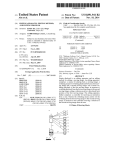

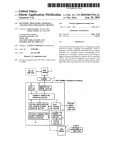
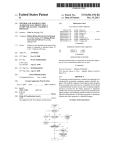
![Page 1 (12) United States Patent Castaldi et a]. US007118220B2](http://vs1.manualzilla.com/store/data/005861806_1-939e513e2a7d3e1f9213dbaf59950ac6-150x150.png)

